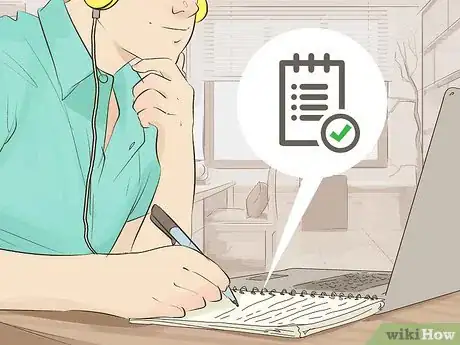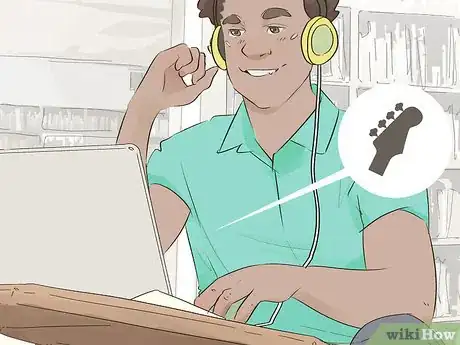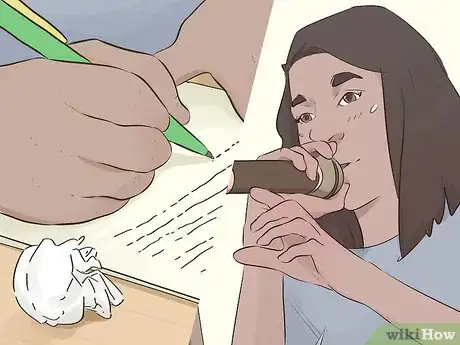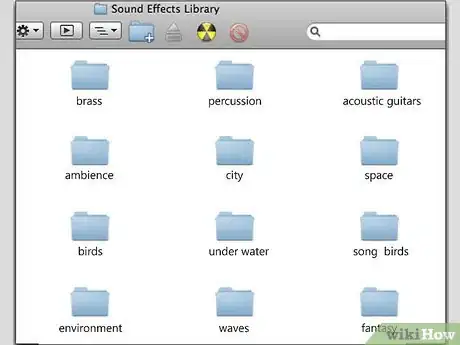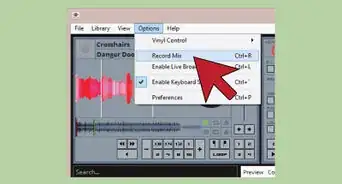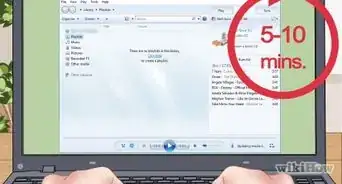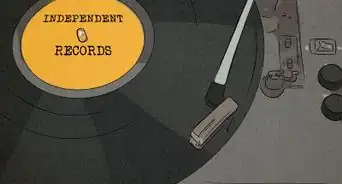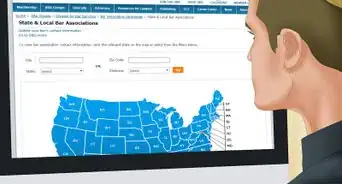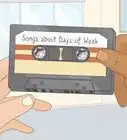This article was co-authored by Timothy Linetsky. Timothy Linetsky is a DJ, producer, and music educator that has been making music for over 15 years. He is a certified Ableton trainer and creates educational YouTube videos focused on producing electronic music. He has over 90,000 YouTube subscribers.
There are 18 references cited in this article, which can be found at the bottom of the page.
wikiHow marks an article as reader-approved once it receives enough positive feedback. In this case, 86% of readers who voted found the article helpful, earning it our reader-approved status.
This article has been viewed 683,347 times.
In the past, making studio-quality music required lots of money and years of training in composition and instrumentation. Now, however, you can create beautiful songs at home with nothing more than a computer, some audio software, and a little bit of practice. Keep reading to learn how to starting making your own songs on a computer.
Steps
Equipping Yourself to Make Music
-
1Select a DAW. DAW stands for Digital Audio Workstation. Different DAWs have different system requirements, so knowing which DAW you’ll use can help you determine the kind of computer you’ll need to build or buy. There are many DAWs available, so you should research the one best for you, but a few popular options include:[1]
- Image-Line FL Studio, which is one of the more robust options in the Fruity Loops brand. As a bonus, this DAW generally includes free updates.
-
Ableton Live is a popular choice among composers and performers. It integrates well with supplemental hardware, like synthesizers and the Push 2 controller.
- Think of controllers as a physical interface for your DAW. By pressing a button on a controller, you can create sound in your DAW.
- Steinberg Cubase Pro is a well-balanced DAW with specialized digital tools, like the chromatic adjustment function in the Sampler Track interface.
- Avid Pro Tools is perhaps the best known DAW among lay-producers. Pro Tools is a dependable DAW that you'll find in many studios.
- Apple Logic Pro is relatively easy to use, with clear labels and intuitive graphical user interface. However, this DAW is only available for Apple products.[2]
- Reaper is a DAW you can download and use for a trial period of 60 days. Following that, you'll be asked to pay $60 or make a donation, but you'll still have the option to decline payment and continue using the program.
-
2Choose the computer you'll use for making music. You can save money on computer costs with a low-end video card since you won’t need sharp graphics to produce music. When using the DAWs Pro Tools, GarageBand, or Logic, consider buying a Mac, as these DAWs are either Mac only releases or run optimally with Mac specifications. Additionally:
- Prioritize laptops for live performing. If you don’t plan on performing, a desktop computer will likely save you money, function better, and last longer.
- Choose a computer with a high processor speed. Your computer should have a 3.0 dual core processor, minimum.
- Outfit your music production computer with at least 8 GB of RAM and 500 GB of hard drive space. This will ensure you have enough space for a sound library and that your computer runs smoothly.[3]
Advertisement -
3Collect production equipment and accessories. Although DAWs can digitally reproduce many instruments, samples of live recordings often sound more authentic.[4] For this reason, you may want or need equipment like keyboards, synthesizers, microphones, controllers, electric guitars, and more.
- This equipment can be very expensive. Prioritize equipment from the most to least useful. Save money over time and buy equipment one piece at a time to build your stockpile.
- When evaluating equipment usefulness, think about your personal skills and abilities. If you are a trained drummer, for example, a digital drum kit would likely be useful.
- Production equipment can also reduce the processing/emulation your computer must do, which can help your computer run smoother.
- Controllers and synthesizers can make physically interacting with your DAW much more intuitive and natural.[5]
-
4Educate yourself about your DAW and equipment. Watch YouTube tutorials for the DAW you’ve selected. Familiarize yourself with its features. Take notes from experienced users and tutorials on how to make your DAW produce music most efficiently.[6]
- Each DAW will be different and have different features. Even if you’re somewhat familiar with the general layout of DAWs, it may take time and training before skillful usage comes naturally.
- There may be free courses online teaching how to use your particular DAW. Professional DAWs oftentimes have tutorials for owners. Search online to find and make use of these resources.
Producing Music with a Computer
-
1Plan the track. Although there are exceptions, generally you should keep the number of parts (including vocals and instruments) in your track to about 5 or 6. Too many parts can create a muddy or oversaturated sound. Choose the tempo (speed) of the music by setting the metronome (sometimes marked by “BPM” (Beats per Minute)).
- Research the genre of the track you’re trying to create. Some genres have specific characteristics, like the typical 90 BPM range for pop songs or the 120 BPM range for house music.
- What do you, as a listener, want to hear in the genre of music you are making? This can be a useful guide to the instruments you choose and the tone of your track.
-
2Build the foundation with a bassline. The bassline is comprised of low-tone pitches and percussion instruments, like drums.[7] This should be fairly simple and repeatable without being tiresome. The trick of a strong bassline is to make it repetitive but catchy.[8]
- Low-tone notes on instruments besides drums can be a part of your bassline. Try including low-tone chords and low-tone single notes on the guitar and piano.
- Loop the main theme of your bassline so it’s steady and plays for most of the track. This main theme may pause during the bridge or change slightly at transitions, like where the verse changes to the chorus.[9]
- The repetitive, twangy bass of Pink Floyd's hit song "Money" and the simple yet insistent low note pulse in "My Generation" by The Who are great examples of famous basslines.[10]
-
3Come up with a melody. The melody is the main part of a track that you would hum along to. The melody is often reflected in the lead vocals. Generally, one instrument, one voice, or the combination of an instrument and a voice creates the melody.[11] The melody should sync with the pulse of the bassline.
- There are many instruments you can use to make the melody, but popular choices include the piano, guitar, trumpet, trombone, flute, violin, and more.
- Try to design your melody so it has contour. The rise and fall of the volume and tone of the melody will be more engaging to audiences.
- If you intend to have vocals, it’s most common to have the vocals sing along with the melody. Write lyrics for your vocals if you plan on including them in your track.[12]
- Popular melodies that you might look to for inspiration for your own include "I Want to Hold Your Hand" by the Beatles and "Respect" by Aretha Franklin.[13]
-
4Add in harmony. Choose one or two new instruments to add harmony to your track. Include these instruments at various points throughout the track. Use a note, a run of notes, or a chord with these instruments to create tension, build, or emphasis at important parts of the song or to highlight lyrics.[14]
- Add supplemental instruments sparingly to your track. Adding too many or having supporting instruments play too frequently can make your track heavy and the sound quality muddy.[15]
- Voices, too, can be added as a supplemental “instrument.” A second/backup voice or chorus, especially during the chorus or emphatic parts, can be effective.[16]
- Listen to the operatic harmony in the internationally famous Queen song "Bohemian Rhapsody," or the equally impressive harmonies of the Beach Boys in "I Get Around."[17]
-
5Emphasize suitable parts of your track. During the middle build of the song you’ll likely want to increase volume and add instruments little by little for its duration. Add an instrument to highlight your favorite lyrics. Hit home the last chorus hard by using a backup chorus to add a sense of weight and depth.[18]
- When it comes to emphasizing your track, it’s completely a matter of preference. Explore different techniques to find what works best for you.
- Unusual sounds, like air raid sirens, rain, and traffic, can sometimes have an unexpectedly positive effect on a track.[19]
- The bitter chorus of "Mr. Brightside" by the Killers is emphasized with additional instruments. Don McLean adds and removes instruments throughout "American Pie" to shift mood, heighten emotion, and more.
-
6Finish your track. Mix your track. Assemble the different parts of the track in your DAW so they fit together seamlessly.[20] Master the track to ensure the volume is balanced between parts. Check any fades and the overall frequency of the song. Moderate extremes so the transition and quality between sounds are both smooth.[21]
- Keep the volume low when finishing your track. You’ll likely spend many hours making small adjustments until you achieve your desired sound. Moderate and high volumes can damage your hearing over time.
- DAWs generally come with finishing tools, like those used for compression. With compression tools, as an example, you can more easily maintain consistent volume throughout a track.
Expanding Your Sound
-
1Build your sound library. Your phone can be a powerful tool for capturing unique sounds. Snag samples of natural features, like rain or birds, snippets of catchy conversation, and music being played in the distance on a still day. Download sound packs from the website of your DAW producer. Ask to sample local bands, musical friends, and others.
- Organize your music library in an orderly system, much like you'd organize physical files. Use headings like "brass," "percussion," and "acoustic guitars."
- Because of the wide variety in some categories, you may want to add subcategories under "master" headings. For example, you might separate "high-hats" and "ride cymbals" under the master heading for "percussion."
-
2Make use of plugins to save money when starting out. Plugins add new qualities to existing programs, like added on search engine features in your web browser. Music production plugins can be used for sound many purposes, like in sound editing, as a DAW, as a supplemental synthesizer, and more.
-
3Familiarize yourself with audio editors. Audio editors help you remove static from recorded tracks, modify sound parameters (frequency) to reduce or adjust distortion, add effects, and more. Some highly ranked free audio editors that are useful for gaining familiarity with them include:
- Audacity is a powerful sound editing program that, even though free, manages to exceed some pay-to-use editing programs. It comes with a comprehensive manual and is approachable for beginners.
- Free Audio Editor has a clear user interface that makes this editor less intimidating. This program has an array of pre-made filters for things like breath and background noise reduction.
- Free MP3 Cutter and Editor is an excellent choice for simple edits or light finishing. Though somewhat less robust, this editor is great for things like splitting one long MP3 into multiple segments.[22]
Community Q&A
-
QuestionHow can I make music at home?
 wikiHow Staff EditorThis answer was written by one of our trained team of researchers who validated it for accuracy and comprehensiveness.
wikiHow Staff EditorThis answer was written by one of our trained team of researchers who validated it for accuracy and comprehensiveness.
Staff Answer wikiHow Staff EditorStaff AnswerIf you’re really serious about recording instruments and singing at home, you could Make Your Own Recording Studio. For computer music recording, you could Build a Home Studio for Computer Based Music Recording. Or, as this article explains above, you can make music on your computer by sitting at your desk and using the computer and its software.
wikiHow Staff EditorStaff AnswerIf you’re really serious about recording instruments and singing at home, you could Make Your Own Recording Studio. For computer music recording, you could Build a Home Studio for Computer Based Music Recording. Or, as this article explains above, you can make music on your computer by sitting at your desk and using the computer and its software. -
QuestionCan you make music on a laptop?
 wikiHow Staff EditorThis answer was written by one of our trained team of researchers who validated it for accuracy and comprehensiveness.
wikiHow Staff EditorThis answer was written by one of our trained team of researchers who validated it for accuracy and comprehensiveness.
Staff Answer wikiHow Staff EditorStaff AnswerYou can make music on a laptop, using appropriate software. However, the less memory on your computer, the less useful a laptop will be for making music. Many music makers recommend keeping the laptop for live performance and using a desktop for music creation. However, if you can afford a powerful laptop with plentiful space, it’ll work fine for making music. Back up everything you make, for certainty.
wikiHow Staff EditorStaff AnswerYou can make music on a laptop, using appropriate software. However, the less memory on your computer, the less useful a laptop will be for making music. Many music makers recommend keeping the laptop for live performance and using a desktop for music creation. However, if you can afford a powerful laptop with plentiful space, it’ll work fine for making music. Back up everything you make, for certainty. -
QuestionHow can I record music at home?
 wikiHow Staff EditorThis answer was written by one of our trained team of researchers who validated it for accuracy and comprehensiveness.
wikiHow Staff EditorThis answer was written by one of our trained team of researchers who validated it for accuracy and comprehensiveness.
Staff Answer wikiHow Staff EditorStaff AnswerYou can record music at home using software on your computer or by using more expensive equipment as part of a home recording studio. You’ll find more detailed advice available here: How to Record a Song at Home Easily.
wikiHow Staff EditorStaff AnswerYou can record music at home using software on your computer or by using more expensive equipment as part of a home recording studio. You’ll find more detailed advice available here: How to Record a Song at Home Easily.
Things You'll Need
- Computer
- Digital Audio Workstation (DAW)
References
- ↑ http://tweakheadz.com/hip-hop-beat-construction-made-easy-the-elements-of-a-beat-arranging-beats-orchestrating-beats-sound-creation-and-production-tips-for-hip-hop/
- ↑ http://www.musicradar.com/tuition/tech/the-20-best-daw-software-apps-in-the-world-today-238905
- ↑ http://www.wirerealm.com/guides/top-10-best-computers-music-production
- ↑ https://mic.com/articles/113504/science-shows-why-drum-machines-will-never-replace-live-drummers#.huFY23FYx
- ↑ http://tweakheadz.com/hip-hop-beat-construction-made-easy-the-elements-of-a-beat-arranging-beats-orchestrating-beats-sound-creation-and-production-tips-for-hip-hop/
- ↑ http://edmprod.com/ultimate-cheat-sheet-becoming-great-producer/
- ↑ Timothy Linetsky. Music Producer & Instructor. Expert Interview. 21 April 2021.
- ↑ http://tweakheadz.com/hip-hop-beat-construction-made-easy-the-elements-of-a-beat-arranging-beats-orchestrating-beats-sound-creation-and-production-tips-for-hip-hop/
- ↑ http://www.learneverythingabout.com/lyrics/song-structure-bridges.html
- ↑ http://www.musicradar.com/news/bass/25-best-basslines-of-all-time-509265
- ↑ https://www.britannica.com/art/melody
- ↑ http://edmprod.com/ultimate-melody-guide/
- ↑ http://www.billboard.com/articles/columns/pop-shop/6731053/greatest-catchiest-pop-hooks-ever
- ↑ https://www.youtube.com/watch?v=Qgw5UsWVDZM
- ↑ http://www.musicradar.com/tuition/tech/10-hip-hop-production-tips-431654
- ↑ http://tweakheadz.com/hip-hop-beat-construction-made-easy-the-elements-of-a-beat-arranging-beats-orchestrating-beats-sound-creation-and-production-tips-for-hip-hop/
- ↑ http://www.theo2.co.uk/news/detail/7-songs-with-utterly-mind-blowing-harmonies
- ↑ http://tweakheadz.com/hip-hop-beat-construction-made-easy-the-elements-of-a-beat-arranging-beats-orchestrating-beats-sound-creation-and-production-tips-for-hip-hop/
- ↑ http://www.musicradar.com/tuition/tech/10-hip-hop-production-tips-431654
- ↑ https://www.landr.com/en/how-to-mix
- ↑ http://www.musictech.net/2016/05/8-ways-to-master-a-track/
- ↑ http://www.techradar.com/news/the-best-free-audio-editor
About This Article
To make a digital song, start by opening up a Digital Audio Workstation, creating a new song file, and setting the file’s tempo to something typical like 120 BPM. So your song has a solid foundation, lay down a repetitive but catchy bassline made of low-tone pitches and percussion instruments. Then, create a vocal or instrumental melody that syncs up with the bassline but has a greater amount of tonal variety. Finally, create harmony tracks that contrast with or highlight parts of your melody. To learn how to mix and master your song, scroll down!




